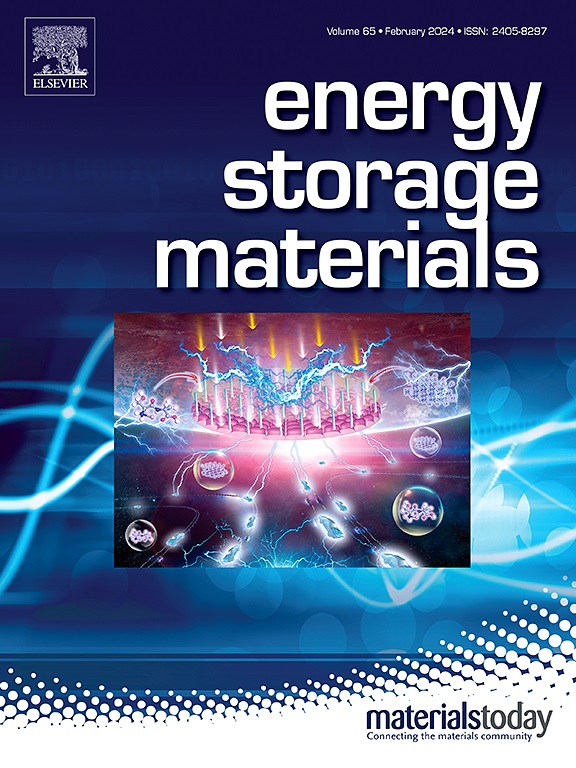用于高性能金属锂电池的高放电深度抗金属疲劳锂薄箔
IF 18.9
1区 材料科学
Q1 CHEMISTRY, PHYSICAL
引用次数: 0
摘要
在锂金属电池中,由于现有锂箔抗金属疲劳能力不足,无法承受充放电循环过程中的剧烈应变,锂阳极容易粉碎化,导致电池短路或容量快速衰减。在实际的高能量密度电池中,需要高放电深度条件,这一问题进一步加剧。为了克服这一问题,采用循环挤压压缩技术制备了具有稳定骨架的金属抗疲劳薄锂(RMFLi)箔。该RMFLi具有比纯Li更好的金属抗疲劳性能,在循环应力和应变下保持其完整性而不开裂或断裂。有限元模拟(FES)和微观形态表征都证明了RMFLi优异的力学性能,特别是其抗金属疲劳性能,在促进Li离子的受控密集沉积和确保阳极在循环过程中的电化学稳定性方面发挥了重要作用。令人印象深刻的是,由于其高抗疲劳性和稳定的骨架,RMFLi箔即使在放电深度高达90.3%的情况下也能实现长期稳定的循环。当与高负载磷酸铁锂(LFP)和S阴极在充满电池中配对时,它分别实现了1000次和600次的稳定循环。值得注意的是,使用这种RMFLi箔的Li-S袋电池具有391.4 Wh kg−1的高能量密度,并且可以稳定循环80次。本研究为金属抗疲劳薄锂箔的制造提供了一种可扩展的机械制备方法,具有巨大的扩展可能性。本文章由计算机程序翻译,如有差异,请以英文原文为准。
Metal-fatigue-resistant thin lithium foil with high depth of discharge for high-performance lithium metal batteries
In Li metal batteries, due to the inadequate resistance to metal fatigue of existing Li foil to withstand the severe strain during charge-discharge cycles, the Li anode is prone to pulverization, which can lead to short circuits or rapid capacity decay of batteries. This issue is further exacerbated in practical high-energy-density batteries that require high discharge depth conditions. To overcome it, a metal-fatigue-resistant thin Li (RMFLi) foil with a stable skeleton has been fabricated by employing a cyclic extrusion compression technique. This RMFLi possesses better metal fatigue resistance than pure Li, maintaining its integrity under cyclic stress and strain without cracking or fracturing. Both finite element simulations (FES) and microscopic morphological characterization provide evidence that the excellent mechanical properties of RMFLi, specifically its resistance to metal fatigue, play a significant role in facilitating controlled dense deposition of Li ions and ensure electrochemical stability of the anode during cycling. Impressively, thanks to its high fatigue resistance and stable skeleton, the RMFLi foil achieves long-term stable cycling even at a discharge depth of up to 90.3 %. When paired with high-load lithium iron phosphate (LFP) and S cathodes in full cells, it achieves stable cycling for 1000 and 600 cycles, respectively. It's worth noting that the Li-S pouch cell utilizing this RMFLi foil exhibits high energy density of 391.4 Wh kg−1 and can cycle stably for 80 cycles. This study provides a scalable mechanical preparation method with tremendous expansion possibilities for manufacturing metal-fatigue-resistant thin Li foils.
求助全文
通过发布文献求助,成功后即可免费获取论文全文。
去求助
来源期刊

Energy Storage Materials
Materials Science-General Materials Science
CiteScore
33.00
自引率
5.90%
发文量
652
审稿时长
27 days
期刊介绍:
Energy Storage Materials is a global interdisciplinary journal dedicated to sharing scientific and technological advancements in materials and devices for advanced energy storage and related energy conversion, such as in metal-O2 batteries. The journal features comprehensive research articles, including full papers and short communications, as well as authoritative feature articles and reviews by leading experts in the field.
Energy Storage Materials covers a wide range of topics, including the synthesis, fabrication, structure, properties, performance, and technological applications of energy storage materials. Additionally, the journal explores strategies, policies, and developments in the field of energy storage materials and devices for sustainable energy.
Published papers are selected based on their scientific and technological significance, their ability to provide valuable new knowledge, and their relevance to the international research community.
 求助内容:
求助内容: 应助结果提醒方式:
应助结果提醒方式:


